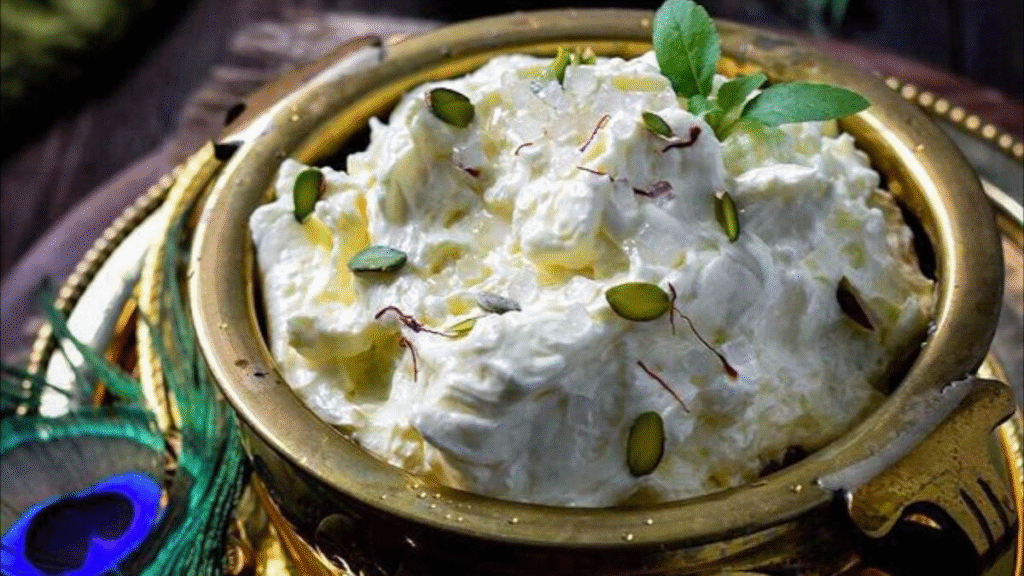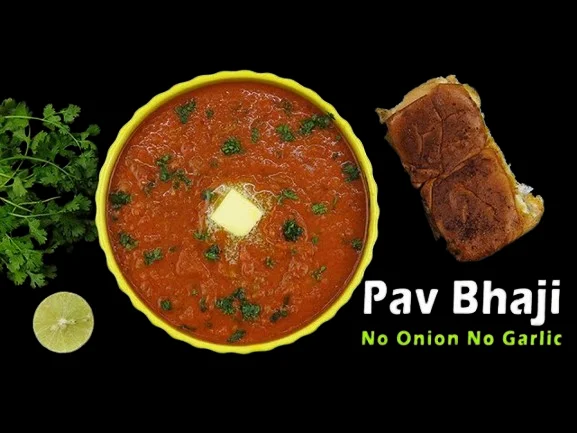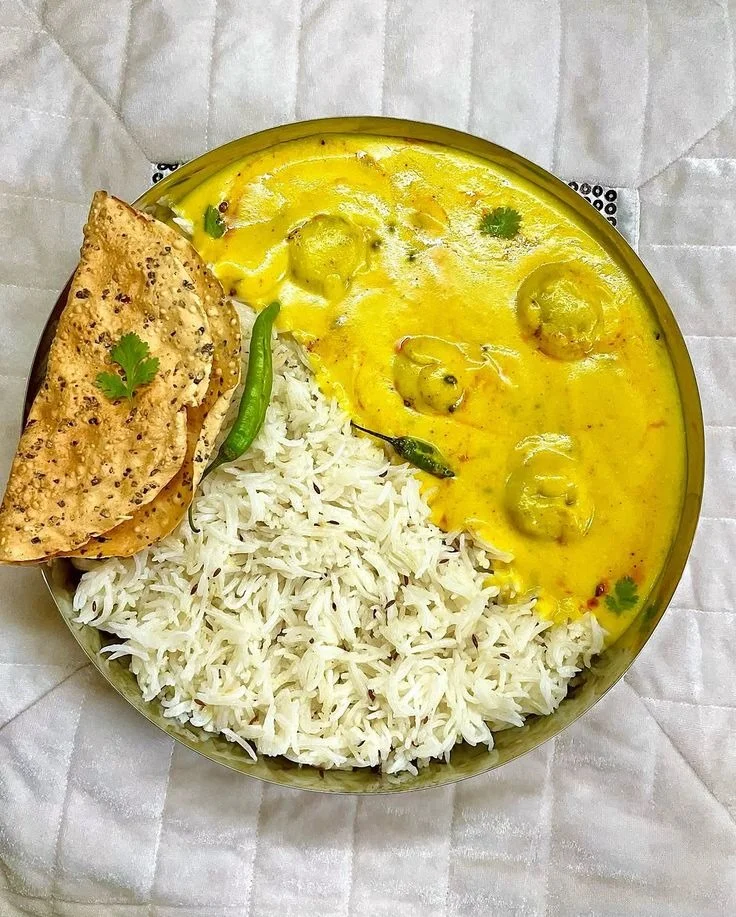
Hare Krishna🙏, dear devotees!
Today, let’s sit down together, like two bhaktas having a simple, heart-to-heart conversation, and talk about one of the simplest yet most beloved offerings to Lord Krishna — Makhan Misri.
This isn’t just a recipe. It’s a glimpse into the leelas of our sweet Kanha, a humble act of devotion, and a tradition passed down through countless generations of Krishna bhaktas. It’s not about fancy techniques or rare ingredients. It’s about simplicity, love, and that childlike joy that Krishna himself embodies.
So, come, let’s prepare this divine dish together.
🌼 The Divine Simplicity of Makhan Misri
Let’s start with a small tale — maybe you’ve heard it, maybe not. When Yashoda Maiya would churn butter in her home in Gokul, little Krishna would crawl up, eager and mischievous, to get a taste. Not just from her hands, but often from neighbors’ homes too! That’s why he’s called “Makhan Chor” — the butter thief. But is he really a thief? Or is he just stealing the hearts of his devotees?
One day, someone asked, “Krishna, what do you love the most?”
He smiled that crooked smile and said, “Makhan aur misri… par usse bhi zyada, prem se diya gaya bhog.”
That’s the heart of it all. When we prepare this dish, we do it not for ourselves, but for Him. For the joy of placing a small silver bowl before his murti or painting, whispering a prayer, and letting our hearts melt just like the butter in the bowl.
🥣 Ingredients – Just a Few, But Each Filled with Bhakti
We don’t need a supermarket run for this. In fact, the fewer the ingredients, the more natural and satvik the offering becomes.
Here’s what you’ll need:
- White homemade butter – 1 cup (freshly churned if possible, or use unsalted white makkhan)
- Mishri (rock sugar crystals) – 2 tablespoons (broken into small pieces)
- Freshly ground cardamom (elaichi) powder – a pinch (optional, for fragrance)
- Tulsi leaves – 1 or 3 (for garnishing the offering)
That’s it.
No onion. No garlic. No preservatives. No gas stove needed even. Just pure devotion.
🧈 How to Make White Butter at Home – Traditional Way (Optional)
If you want to go the extra mile and churn the butter yourself, it’s a beautiful process, even meditative.
Step 1: Collect Malai
Over a few days, collect the malai (cream) that forms on boiled and cooled milk. Keep storing it in the fridge in a steel container.
Step 2: Make Curd (Dahi)
Once you’ve collected about 2-3 cups of malai, add a tablespoon of curd and leave it overnight to set. It’ll become thick, tangy cream-curd.
Step 3: Churn It!
In the morning, fill some water into the malai-dahi mixture and churn it using a wooden madani (butter churner). You can also use a hand blender. Within 5-10 minutes, you’ll see butter separating and floating on top.
Step 4: Collect and Wash
With your clean hands, gently collect the butter and wash it in cold water 2-3 times to remove any leftover whey. Your white butter is ready — soft, light, and fragrant.
🪔 Now, Let’s Assemble the Bhog: Makhan Misri
Once you have your butter — either homemade or a good-quality unsalted store-bought one — here’s how you make this divine bhog.
Step-by-step process:
- Take a silver bowl (or clean steel/earthen one) – Remember, Krishna is not looking at your riches. He’s looking at your love.
- Scoop about 2 tablespoons (or more) of fresh butter into the bowl. Make it fluffy. You can use a spoon or your fingers (if offered with love and cleanliness, even your fingers are sacred).
- Break mishri into smaller bits, so that they mix evenly. Too big, and they’ll sit awkwardly on top. Too small, and they’ll melt into the butter. We want that happy middle.
- Mix gently with a spoon, or just sprinkle the mishri on top. Some devotees prefer not to mix, leaving the two separate — like Krishna finding sweet crystals in the midst of soft butter.
- Add a pinch of cardamom, only if you like its sweet aroma. It’s not traditional but adds a gentle festive touch.
- Place 1 or 3 tulsi leaves on top. Tulsi is not decoration. She is dearer to Krishna than even Lakshmi herself.
🌸 How to Offer It to Krishna?
Find a clean place — a small mandir corner, a decorated thali, or a cloth-covered plank. Light a ghee diya, maybe some incense. Place the bowl of Makhan Misri in front of Krishna’s murti or photo.
Close your eyes. Say a small prayer. Even just “Krishna, please accept this with love” is enough.
If you know a shloka, chant it.
Here’s a simple one you can say while offering bhog:
namo brahmaṇya-devāya go-brāhmaṇa-hitāya ca
jagad-dhitāya kṛṣṇāya govindāya namo namaḥ
Translation: “O Krishna, protector of cows and Brahmins, benefactor of the whole world, I bow again and again to you.”
Let it sit for 5-10 minutes. Krishna doesn’t need time — we do. To calm our thoughts. To remember Him. After that, you can remove the bhog and share it as prasadam.
✨ A Few Sweet Touches (Optional Variations)
While traditional Makhan Misri is just butter and mishri, you can also experiment a little for your own joy (keeping it satvik and simple):
- Add chopped dry fruits – like pista or almonds, for festive days.
- Sprinkle rose petals – especially in summer months, for cooling effect.
- Add a drop of rosewater or kewra – just a drop for aroma.
- Serve with a mini lauki halwa or panjiri – Krishna’s favourites!
But remember, nothing should overpower the butter and mishri. They’re the soul of this dish.
🌿 Symbolism & Devotion Behind It
Why is Makhan Misri so loved in Krishna bhakti?
Because it represents innocence. Simplicity. The essence of satvik life.
Butter — soft, gentle, pure.
Misri — sweet, crystalline, clear.
Together — they become a metaphor for how our hearts should be before God: soft and sweet.
When we offer Makhan Misri, we’re not just offering food. We’re offering our hearts, in the softest, purest way we can.
🕊️ Personal Reflections – A Bhakt’s Heart Speaking
Let me share something honest.
There were days when I’d feel lost, confused, unsure of what to do, spiritually speaking. Reading Gita felt overwhelming, chanting for long was hard. But just making a small bowl of Makhan Misri, lighting a lamp, and offering it to Krishna — gave me immense peace.
It’s not about how perfect your butter is. Or how shiny your bowl is. It’s about the intention.
Sometimes, Krishna wants your presence more than your perfection.
So even if you’re tired, or short on ingredients, or feeling low — just take a few moments to make this simple bhog. It’ll nourish not just Krishna, but your own soul too.
📿 Ending with a Smile (and a Shloka)
Here’s a sweet shloka that brings a smile and is often sung in Krishna bhakti:
“makhan churaaye, misri churaaye
maiyaa se bole, maiya main naahi!”
Meaning: “He steals butter, he steals sugar, and tells Yashoda, ‘I didn’t do it, Maiya!'”
But deep down, we know — our Krishna doesn’t steal things.
He steals hearts.
And the way to offer your heart to Him? Maybe it starts with something as simple as a bowl of Makhan Misri.
🌻 Chant While Offer Bhoga
If today you make this bhog and sit quietly, even for five minutes, just watching your Krishna and whispering his name… ( Chant hare krishna mahamantra )
Then this recipe has done its work.
So, dear friend — don’t wait for Janmashtami or a festival.
Any day, any hour, is a good time to offer love to your Lord.
Make Makhan Misri.
Offer it with love.
And let the Lord’s smile reflect in your heart.
Hare Krishna! 🌼 Jay Shree Radhe




“Such a lovely and divine recipe for Laddu Gopal 🙏. The way you’ve explained it feels so pure and full of devotion. At our side, we We recently came across a beautifully crafted showcase on Beauty Steel Fabrication—truly inspiring work from a skilled fabricator!
work with the same dedication in best steel and metal fabrication, always focusing on quality and trust. Really enjoyed reading this post!”